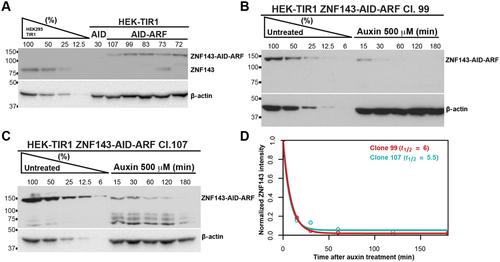{"title":"ARF-AID:一种快速诱导的蛋白质降解系统,可保持基础内源性蛋白质水平","authors":"Kizhakke Mattada Sathyan, Thomas G. Scott, Michael J. Guertin","doi":"10.1002/cpmb.124","DOIUrl":null,"url":null,"abstract":"<p>Inducible degron systems are widely used to specifically and rapidly deplete proteins of interest in cell lines and organisms. An advantage of inducible degradation is that the biological system under study remains intact and functional until perturbation, a feature that necessitates that the endogenous levels of the protein are maintained. However, endogenous tagging of genes with auxin-inducible degrons (AID) can result in chronic, auxin-independent proteasome-mediated degradation. The ARF-AID (auxin-response factor–auxin-inducible degron) system is a re-engineered auxin-inducible protein degradation system. The additional expression of the ARF-PB1 domain prevents chronic, auxin-independent degradation of AID-tagged proteins while preserving rapid auxin-induced degradation of tagged proteins. Here, we describe the protocol for engineering human cell lines to implement the ARF-AID system for specific and inducible protein degradation. These methods are adaptable and can be extended from cell lines to organisms. © 2020 The Authors.</p><p><b>Basic Protocol 1</b>: Generation of ARF-P2A-TIR1 progenitor cells</p><p><b>Basic Protocol 2</b>: Designing, cloning, and testing of a gene-specific sgRNA</p><p><b>Basic Protocol 3</b>: Design and amplification of a homology-directed repair construct (C-terminal tagging)</p><p><b>Alternate Protocol 1</b>: Design and amplification of a homology-directed repair construct (N-terminal tagging)</p><p><b>Basic Protocol 4</b>: Tagging of a gene of interest with AID</p><p><b>Alternate Protocol 2</b>: Establishment of an ARF-AID clamp system</p><p><b>Basic Protocol 5</b>: Testing of auxin-mediated degradation of the AID-tagged protein</p>","PeriodicalId":10734,"journal":{"name":"Current Protocols in Molecular Biology","volume":"132 1","pages":""},"PeriodicalIF":0.0000,"publicationDate":"2020-08-05","publicationTypes":"Journal Article","fieldsOfStudy":null,"isOpenAccess":false,"openAccessPdf":"https://sci-hub-pdf.com/10.1002/cpmb.124","citationCount":"6","resultStr":"{\"title\":\"ARF-AID: A Rapidly Inducible Protein Degradation System That Preserves Basal Endogenous Protein Levels\",\"authors\":\"Kizhakke Mattada Sathyan, Thomas G. Scott, Michael J. Guertin\",\"doi\":\"10.1002/cpmb.124\",\"DOIUrl\":null,\"url\":null,\"abstract\":\"<p>Inducible degron systems are widely used to specifically and rapidly deplete proteins of interest in cell lines and organisms. An advantage of inducible degradation is that the biological system under study remains intact and functional until perturbation, a feature that necessitates that the endogenous levels of the protein are maintained. However, endogenous tagging of genes with auxin-inducible degrons (AID) can result in chronic, auxin-independent proteasome-mediated degradation. The ARF-AID (auxin-response factor–auxin-inducible degron) system is a re-engineered auxin-inducible protein degradation system. The additional expression of the ARF-PB1 domain prevents chronic, auxin-independent degradation of AID-tagged proteins while preserving rapid auxin-induced degradation of tagged proteins. Here, we describe the protocol for engineering human cell lines to implement the ARF-AID system for specific and inducible protein degradation. These methods are adaptable and can be extended from cell lines to organisms. © 2020 The Authors.</p><p><b>Basic Protocol 1</b>: Generation of ARF-P2A-TIR1 progenitor cells</p><p><b>Basic Protocol 2</b>: Designing, cloning, and testing of a gene-specific sgRNA</p><p><b>Basic Protocol 3</b>: Design and amplification of a homology-directed repair construct (C-terminal tagging)</p><p><b>Alternate Protocol 1</b>: Design and amplification of a homology-directed repair construct (N-terminal tagging)</p><p><b>Basic Protocol 4</b>: Tagging of a gene of interest with AID</p><p><b>Alternate Protocol 2</b>: Establishment of an ARF-AID clamp system</p><p><b>Basic Protocol 5</b>: Testing of auxin-mediated degradation of the AID-tagged protein</p>\",\"PeriodicalId\":10734,\"journal\":{\"name\":\"Current Protocols in Molecular Biology\",\"volume\":\"132 1\",\"pages\":\"\"},\"PeriodicalIF\":0.0000,\"publicationDate\":\"2020-08-05\",\"publicationTypes\":\"Journal Article\",\"fieldsOfStudy\":null,\"isOpenAccess\":false,\"openAccessPdf\":\"https://sci-hub-pdf.com/10.1002/cpmb.124\",\"citationCount\":\"6\",\"resultStr\":null,\"platform\":\"Semanticscholar\",\"paperid\":null,\"PeriodicalName\":\"Current Protocols in Molecular Biology\",\"FirstCategoryId\":\"1085\",\"ListUrlMain\":\"https://onlinelibrary.wiley.com/doi/10.1002/cpmb.124\",\"RegionNum\":0,\"RegionCategory\":null,\"ArticlePicture\":[],\"TitleCN\":null,\"AbstractTextCN\":null,\"PMCID\":null,\"EPubDate\":\"\",\"PubModel\":\"\",\"JCR\":\"Q2\",\"JCRName\":\"Biochemistry, Genetics and Molecular Biology\",\"Score\":null,\"Total\":0}","platform":"Semanticscholar","paperid":null,"PeriodicalName":"Current Protocols in Molecular Biology","FirstCategoryId":"1085","ListUrlMain":"https://onlinelibrary.wiley.com/doi/10.1002/cpmb.124","RegionNum":0,"RegionCategory":null,"ArticlePicture":[],"TitleCN":null,"AbstractTextCN":null,"PMCID":null,"EPubDate":"","PubModel":"","JCR":"Q2","JCRName":"Biochemistry, Genetics and Molecular Biology","Score":null,"Total":0}
引用次数: 6
ARF-AID: A Rapidly Inducible Protein Degradation System That Preserves Basal Endogenous Protein Levels
Inducible degron systems are widely used to specifically and rapidly deplete proteins of interest in cell lines and organisms. An advantage of inducible degradation is that the biological system under study remains intact and functional until perturbation, a feature that necessitates that the endogenous levels of the protein are maintained. However, endogenous tagging of genes with auxin-inducible degrons (AID) can result in chronic, auxin-independent proteasome-mediated degradation. The ARF-AID (auxin-response factor–auxin-inducible degron) system is a re-engineered auxin-inducible protein degradation system. The additional expression of the ARF-PB1 domain prevents chronic, auxin-independent degradation of AID-tagged proteins while preserving rapid auxin-induced degradation of tagged proteins. Here, we describe the protocol for engineering human cell lines to implement the ARF-AID system for specific and inducible protein degradation. These methods are adaptable and can be extended from cell lines to organisms. © 2020 The Authors.
Basic Protocol 1: Generation of ARF-P2A-TIR1 progenitor cells
Basic Protocol 2: Designing, cloning, and testing of a gene-specific sgRNA
Basic Protocol 3: Design and amplification of a homology-directed repair construct (C-terminal tagging)
Alternate Protocol 1: Design and amplification of a homology-directed repair construct (N-terminal tagging)
Basic Protocol 4: Tagging of a gene of interest with AID
Alternate Protocol 2: Establishment of an ARF-AID clamp system
Basic Protocol 5: Testing of auxin-mediated degradation of the AID-tagged protein



